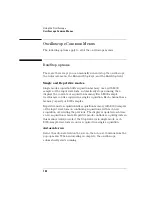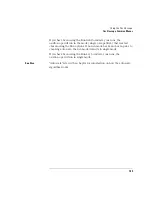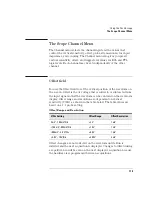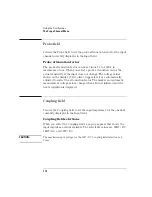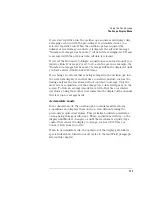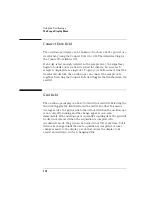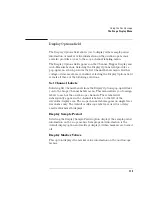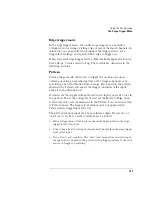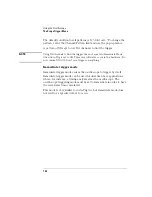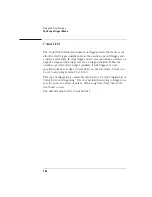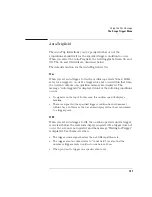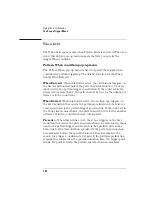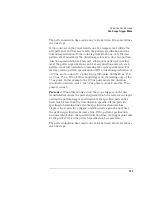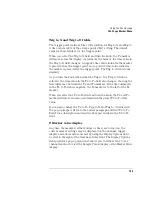
121
Using the Oscilloscope
The Scope Trigger Menu
Edge trigger mode
In the edge trigger mode, the oscilloscope triggers at a specified
voltage level on a rising or falling edge of one of the input channels. In
this mode you can specify which input is the trigger source, set a
trigger level voltage, and specify which edge to trigger on.
When you select edge trigger mode, additional fields appear for Source,
Level, Slope, Count, and Auto-Trig. These fields are discussed in the
following sections.
Pattern
Pattern trigger mode allows you to trigger the oscilloscope upon
entering or exiting a specified pattern of the trigger channels or by
specifying a pattern duration time or range. Each entry in the pattern
shown in the Pattern row shows the trigger condition of the input
above it in the Channel row.
You must set the trigger voltage level for each input you want to use in
the pattern. To set the voltage level, first set the Mode to Edge, then
set the level for each channel used in the Pattern. You can then return
to Pattern mode. The trigger level marker does not appear when
Pattern mode triggering is selected.
The pattern for each input may be specified as high (H), low (L), or
"don’t care" (X). H, L, and X conditions are as follows:
•
H-the voltage value of this input channel must be greater than the edge
trigger level of this input.
•
L-the voltage level of this input channel must be less than the edge trigger
level of this input.
•
X-is a "don't care" condition. The "don't care" means the associated input
channel will not be used in the pattern for the trigger qualifier. It does not
equate to "trigger on anything."
Summary of Contents for 1670E Series
Page 6: ...6 In This Book...
Page 26: ...26 Contents...
Page 27: ...27 Section 1 Logic Analyzer...
Page 28: ...28...
Page 29: ...29 1 Logic Analyzer Overview...
Page 39: ...39 2 Connecting Peripherals...
Page 49: ...49 3 Using the Logic Analyzer...
Page 72: ...72 Using the Logic Analyzer The Inverse Assembler...
Page 73: ...73 4 Using the Trigger Menu...
Page 101: ...101 5 Using the Oscilloscope...
Page 151: ...151 6 Using the Pattern Generator...
Page 199: ...199 7 Triggering Examples...
Page 237: ...237 8 File Management...
Page 249: ...249 9 Logic Analyzer Reference...
Page 360: ...360 Logic Analyzer Reference The Compare Menu...
Page 361: ...361 10 System Performance Analysis SPA Software...
Page 397: ...397 11 Logic Analyzer Concepts...
Page 430: ...430 Logic Analyzer Concepts The Analyzer Hardware Oscilloscope board theory Oscilloscope board...
Page 439: ...439 12 Troubleshooting the Logic Analyzer...
Page 455: ...455 13 Specifications...
Page 471: ...471 14 Operator s Service...
Page 479: ...479 Operator s Service Troubleshooting Troubleshooting Flowchart 2...
Page 491: ...491 Section 2 LAN...
Page 492: ...492...
Page 493: ...493 15 Introducing the LAN Interface...
Page 497: ...497 16 Connecting and Configuring the LAN...
Page 506: ...506 Connecting and Configuring the LAN Connecting and Configuring the LAN...
Page 507: ...507 17 Accessing the Logic Analyzer File System Using the LAN...
Page 515: ...515 18 Using the LAN s X Window Interface...
Page 527: ...527 19 Retrieving and Restoring Data Using the LAN...
Page 539: ...539 20 Programming the Logic Analyzer Using the LAN...
Page 546: ...546 Programming the Logic Analyzer Using the LAN Programming the Logic Analyzer Using the LAN...
Page 547: ...547 21 LAN Concepts...
Page 555: ...555 22 Troubleshooting the LAN Connection...
Page 580: ...580 Troubleshooting the LAN Connection Getting Service Support...
Page 581: ...581 Section 3 Symbol Utility...
Page 582: ...582...
Page 583: ...583 23 Symbol Utility Introduction...
Page 588: ...588 Symbol Utility Introduction Symbol Utility Introduction...
Page 589: ...589 24 Getting Started with the Symbol Utility...
Page 597: ...597 25 Using the Symbol Utility...
Page 609: ...609 26 Symbol Utility Features and Functions...


